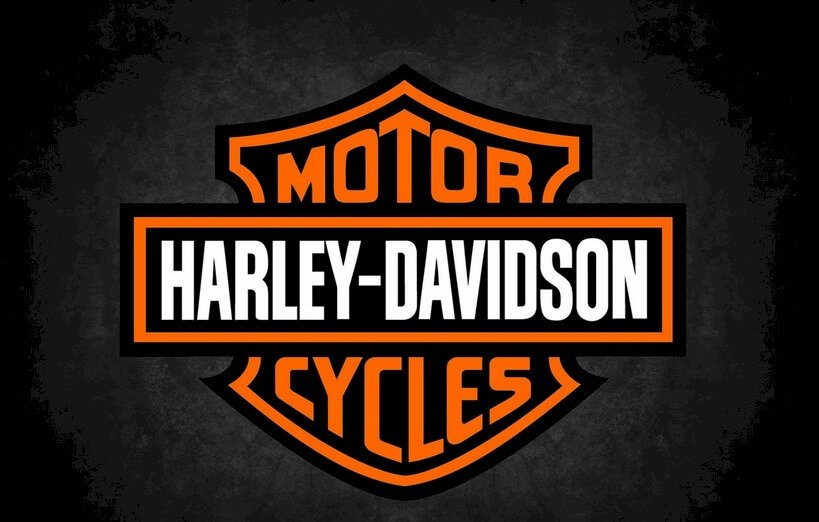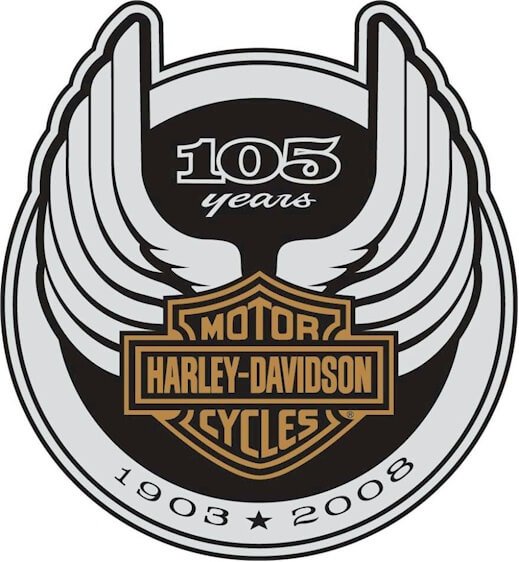When it comes to motorcycles, many people are familiar with the classic Harley Davidson logo. Established in a shed in 1903, Harley Davidson is one of the world’s biggest motorcycle manufacturers. It is renowned for its hulking but highly customizable motorbikes that boast powerful engines.
The Harley logo’s geometric shape and orange and bold-black color combinations create a logo that’s as interesting and powerful as its iconic motorbikes. The shied, which symbolizes a sense of authority and power, is meant to replicate the authority and power you get from riding, as well as the ability to take charge of your own life.
Some past Harley Davidson logos had eagles with spread-out wings. The eagle signifies emancipation, and when you think of something liberating, you think of the capacity to fly. There was arguably no better way to capture this feeling than using one of the most revered creatures in America.
No matter the number of changes the logo has undergone throughout the years, most versions have always retained the iconic, beautiful shield. The shield represents stability and strength, which are two qualities you’d look for in a motorbike. We’d want to have these qualities as well, so that’s why so many motorcycle freaks feel bonded with the Harley Davidson logo.
Harley Davidson Logo Origins
Harley Davidson was founded by William S. Harley, Walter Davidson, and Arthur Davidson back in 1903. However, the founders didn’t have a logo for their young company until 1910, when they adopted the basic-but-effective shield and bar design with the company’s name written in bold.
Since then, all of the company’s logo versions throughout the decades have been modeled around the original version. Now you can be thankful for that semblance of history every time you spot a Harley Davidson motorbike blazing through Sun Prairie!
The Harley Davidson Logo Evolution

Throughout the history of Harley Davidson, its logo has undergone numerous changes. For instance, the 1930 version had only the company’s name written in red with a yellow outline on a white backdrop. In the 1933 version, the emblem was retained, but the background was changed to orange and black. As a result, the inscription was highlighted much better.
From 1940 to 1946, the logotype had a metal drop-shaped look with the inscription “Harley Davidson.” In 1955, a new large-size letter V (in a nod to the popular engine V-twin) showed up on the backdrop of the classy Harley Davidson inscription.
1910: Original Harley Davidson Logo
Harley Davidson officially made its first motorbike in 1903, but the company’s first official logo appeared only in 1910. That year is thought to be the start of the Harley Davidson logo history.
1953: Golden Jubilee Logo
In 1929, Harley Davidson came up with a V-shaped engine. The new engine was such a massive hit that it was in use until 1972, going through a few modernization stages. To celebrate its 50th anniversary in 1953, the company decided to come up with a new logo version, in honor of its V-shaped engine, which brought record success to the firm.
The letter “V” on the memorial logo signifies the V-twin engine. This version of the Harley Davidson logo was seen on motorcycle front fenders in 1954. The emblem was designed inside a circle, with the V outside its bounds. Located in the upper section of the shield was an inscription “Harley Davidson,” “50 Years”, as well as “American Made.”
1965: Most Popular Harley Davidson Logo
This is the year in which the most popular Harley Davidson logo of today was introduced. While the logo itself is basic, it’s got a more modern design and form with the same shield and bar. This version today appears on the motorcycles manufactured by the company.
2003: Centenary Logo
To celebrate Harley Davidson’s 100 years of existence in 2003, the company introduced a new logo design. It consisted of the same shield and bar, with wings placed around them.
On either side of the wings, the dates 1903 (year of the company’s founding) and 2003 (year of the company’s 100th anniversary) were placed. There was a figure, 100, under the shield and bar. This is one of the most common Harley Davidson logos, and it appears on the company’s motorcycles and related accessories.
2008: 105th Harley Davidson Anniversary Logo
In 2008, Harley Davidson celebrated its 105 years of operations by introducing another commemorative logo that looked like the 2003 version. The shield and bar were positioned in the center of the circle, which was orange, black, and the curved wings rose from the shield’s edges and went past the ring.
Between the logo’s wings, there was the lettering “105 years”, and the period 1903-2008 was placed along the outline of the ring at the bottom. This logo design appeared only on Rocker, Rocker C, and Dyna Fat Bob motorcycles that were manufactured that year.
Current Harley Davidson Logo

The shield and bar design has been used in numerous variants of the Harley Davidson logo over the years. Sometimes this version, made in the classic combination of black and orange, appeared on motorcycles. Also, there are versions of basic, crisp, steel logo design.
The Harley Davidson Logo Design Elements
Emblem: Throughout the history of Harley Davidson, its motorbikes and company emblem markedly changed. The Harley Davidson emblem was in different shapes, sizes, and colors, but the inscription has always stayed the same. It’s the main unchanging attribute.
The most popular emblem that’s still in use, shield, and bar, carries an air of mystery. It’s not yet known who authored it. The emblem is designed in a shield shape with a broad horizontal stripe at the center. There are two variations of color: the first one is white letters against a black backdrop, while the second is the inscription Harley Davidson in white, with the remaining inscription in orange.
Color: While Harley Davidson has changed from a black and white theme to a serious “chrome” appearance, the current black and orange theme is a much better fit for the brand. Black has been Harley Davidson’s go-to color for quite a while. When you see black, you typically think of class, elegance, simplicity, and sleekness. Then again, black can also be edgy, which is an apt way to summarize riding.
Lastly, the orange element strikes a fine balance between being inviting and assertive. After all, we all are supposed to get along, isn’t it? Well, Harley Davidson couldn’t agree more!
Orange is both enthusiastic and creative—it radiates energy in a way that black does not. And, of course, some folks have joked that Harley Davidson’s choice of color is a little Halloween-themed. But others see sense in the color choice.
While black radiates edge and simplicity, orange promotes Harley Davidson’s energy and personality. And the touch of white seen around the logo isn’t lost on the company either, because it promotes balance and purity.
Font: Although Harley Davidson played around with some script typefaces when it kept altering its logo, such fonts were extremely rare. The majority of the company’s logos have featured stylish, blocky sans serif fonts.
The History of Harley Davidson
In 1903, is when the Wright brothers flew for the first time and Henry Ford established the Ford Motor Company, and the Harley Davidson Motor Company was founded by William S. Harley and his pals Walter and Arthur Davidson. They gave their Motorcycle a powerful engine that could win races but intended to make it a means of transport.
That same year, the first-ever Harley Davidson motorcycle was sold in Chicago by a merchant named C.H Lange. Of course, Chicago is a city that’s known for its love of auto-touring and “moto racing.” Another brother from the Davidson family, William, joined the firm, which soon outgrew its manufacturing plant and had to shift to larger premises in Milwaukee, Wisconsin in 1906.
From the start, the Harley Davidson motorbike started setting records. For instance, in 1908, the Motorcycle set a record of over 188 miles per gallon. In motorcycle racing in 1910, it achieved seven first-place finishes and, by 1912, boasted 200 distributors in the United States.
During the 1960s, the Harley Davidson motorcycle was affectionately known as “the hog.” It scored seven consecutive wins at the Daytona 500. In the next decade, this Motorcycle won 4 successive AMA Grand National Championship titles and shattered the record for land speed.
The Harley Davidson motorcycle developed to become the most recognized motorbike in the U.S, but it wasn’t the first. In 1867, Howard Roper built a coal-powered steam engine motorbike, while Gottlieb Daimler had created a gas-powered motorbike in 1885, attaching it to a wooden bicycle. That marked the era when the twin development of the modern bicycle and a useful gas-powered engine collided.
Turn of the 19th-century inventors who experimented with both the bicycle and engine elected to take three routes. For example, Daimler made automobiles, men like the Davidsons and Harley developed motorcycles, and the Wright brothers went on to fly airplanes. Their business competitors included other new start-ups such as Schikel, Pierce, Thor, Merkel, Indian, and Excelsior.

During the First World War, Harley Davidson manufactured almost 20,000 motorbikes for the United States government. And during the Second World War, almost all of the motorbikes manufactured by Harley Davidson were used in the war. As countries like England were eventually forced to quit motorcycle production in favor of tank and airplane manufacture, Harley Davidson’s motorbikes were shipped abroad to U.S. allies.
After the Second World War, Harley Davidson’s myth and market share continued to grow. Indian Motorcycle, its major U.S. competitor, halted motorcycle manufacture in the 1950s. Moreover, veteran bike owners, new motorcyclists, and even movies like Easy Rider boosted Harley Davidson’s profile among Americans. Glamorous stars photographed with Harleys, including Jayne Mansfield, Elvis Presley, and Peter Fonda, definitely enriched the company’s image.
Harley Davidson has grown and evolved from its humble origins to a global brand. But irrespective of how much the logo has changed throughout the years, you can always count on Harley Davidson to produce a high-quality, cutting-edge motorcycle.
Harley Davidson Timeline
1903: The first Harley Davidson motorcycle was made by William Harley, Arthur Davidson, and Walter Davidson in Milwaukee.
1909: The first-ever Harley Davidson V-twin engine is introduced.
1936: The Knucklehead, Harley Davidson’s first-ever overhead-valve engine, is introduced. Harley Davidson is one of just two American motorcycle manufacturers to survive the Great Depression. The other is Indian Motorcycles.
1945-45: Over 90,000 Harley Davidson motorcycles are manufactured for the U.S. Army and its associates during the Second World War.
1957: Harley Davidson introduces the XL Sportster motorcycle. The same year, Harley Davidson offers its shares to the public.
1971: The FX Super Glide model is introduced. It’s Harley Davidson’s first custom-made Motorcycle and is a precursor to models such as today’s Softail Deuce.
1981: In a leveraged takeover, 13 Harley Davidson senior executives buy the firm from AMF.
1984: The revolutionary V-twin engine is introduced. The same year, the first of the Softail motorbike series is introduced.
1986: Harley Davidson is taken over by the public once again, with each share trading at $11 at its initial public offering.
1998: Harley Davidson acquires Buell. Over 100,000 motorcycle buffs flock to Milwaukee to mark the firm’s 95th birthday.
2001: Harley Davidson releases the V-rod, which is equipped with the company’s first-ever liquid-cooled engine.
2003: The Harley Davidson Motor Company marks its centenary with a worldwide, year-long celebration.
Last Word
When it comes to motorbikes, the first brand that always springs up in people’s minds is Harley Davidson. This iconic American brand and the Harley Logo has become the byword for class, power, and passion among motorcycle freaks worldwide.
From an initial dream of trying to make light work of cycling, Harley Davidson has grown into an iconic brand that’s recognized all over the planet. It has survived several upheavals like the Great Depression, strikes, and buyouts and continues to go from strength to strength. Its future certainly looks brighter than ever!










